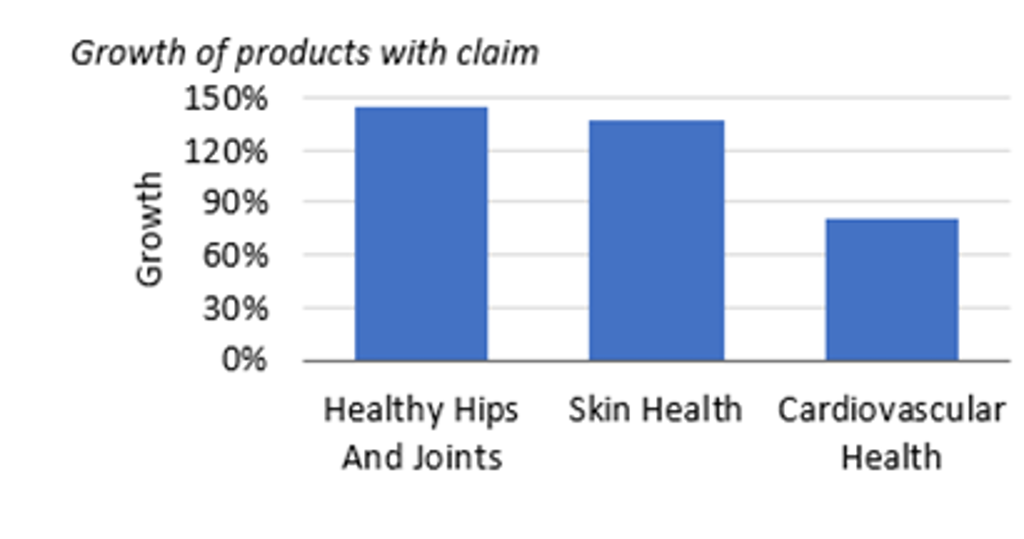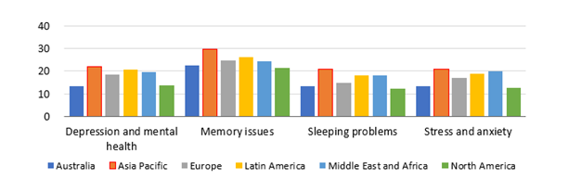Life expectancy has increased in Asia Pacific, with health in most countries in the region improving significantly. Longevity has been accompanied by a greater number of healthy life years. The desire to be healthier is also moving away from fighting the signs of ageing to focusing on prevention and looking and feeling good at any age.
With a wish to stay healthy in their old age, consumers are fuelling demand for health and wellness, ranging from food and nutrition to activities. However, the demand is not merely exclusive to the elderly, with middle-aged or even younger consumers increasingly expressing an interest in holistic healthy living during the natural process of ageing.
Euromonitor International uses a 3-pillar framework that includes nutritional habits, physical wellness, and internal balance to identify wellness opportunities in the region.
Nutritional habits: Specific nutritional needs addressed through functional food and fortification
Consumers are reconsidering their eating habits as a preventative measure to keep themselves in good health, with many looking to increase their intake of healthy nutrients.
With a deeply embedded culture of traditional healing and supplementation, Asia Pacific offers opportunities for traditional ingredients, ancient herbs and botanicals, as well as for product innovation. In fact, younger generations in Asia Pacific are rediscovering the therapeutic virtues of ancient medicine (traditional Chinese medicine, Ayurveda), and manufacturers are responding with attractively-packaged formulations and novel formats. This trend also benefits food and drinks that incorporate well-known traditional ingredients that deliver various functionalities.
As consumers take greater ownership of their health and diet, there is an increasing opportunity for food manufacturers to address specific nutritional needs through functional food and fortification. Food with health benefits in particular is playing a more important role among the elderly. For this cohort, deficient nutrition is a contributory factor to the prevalence and severity of non-communicable diseases related to cardiovascular, cognitive, musculoskeletal and ophthalmological functions.
Asia Pacific: Fastest Growing Health Claims in Packaged Food and Beverages 2019-2020
Physical wellness: The search for more holistic solutions for healthy body and appearance
Asian consumers are becoming increasingly proactive in their efforts to remain healthy and energetic for as long as they can, with the focus on ageing well. This implies a more holistic view of physical wellness, which includes the health of the body and the ability to carry out physical activity without pain, in addition to having a healthy appearance. This approach also relates to hygiene, sleeping habits, and the social capital of engaging in sporting activities, which positively impact one's mental wellbeing.
For instance, the search for physical wellness is reflected in a consumer focus on the skin's health and physical appearance, with the definition of beauty becoming more intertwined with wellness. According to Euromonitor International's Beauty Survey in 2021, almost 50% of respondents equated beauty with looking healthy, higher than other factors such as hygiene or being comfortable in one's skin. Linked to this is the simplification of beauty regimes, with consumers moving away from multi-step beauty routines to focus on healthy-looking and healthy-feeling skin.
Asia Pacific Definition of Beauty 2021

Similarly, Asian consumers increasingly rely on supplementation through sports nutrition to maintain a balanced diet that supports physical wellness. Government policy has further endorsed this growing demand for sports nutrition with programmes and initiatives to encourage participation in physical activities.
Internal balance: Growing recognition of preventative measures and technology-enabled treatments
Internal balance is closely related to lifestyle, measured by factors including mental health, memory, sleep and stress, none of which are mutually exclusive. Asian consumers have prioritised more tangible issues such as nutrition before. However, the pandemic has heightened concerns, leading to prioritisation of these issues. According to Euromonitor International’s Voice of the Consumer: Health and Nutrition Survey, a high proportion of respondents in Asia Pacific see those issues as long-term health concerns, more so than currently, with the region contributing to the highest percentage in the world.
Long Term Health Concerns
In Asia Pacific, compared to dietary supplements which usually attract sophisticated consumers in developed markets, functional food and beverages, such as snacks and RTDs, are more affordable and familiar solutions to help build daily prevention routines of all age groups. In addition to preventive measures, sitting between professional counselling and self-education, guided self-help is a service middle ground, and the digitalisation of such services can be key post-pandemic, as it significantly increases accessibility and reduces costs.
Wellness market in Asia Pacific ripe for reinvention and significant value expansion
Asia Pacific shows a consistently high projected propensity for per capita spending on wellness. The positive outlook offers opportunities in a broader wellness context.
Alongside opportunities in terms of catering for elderly populations, supported by increasing life expectancy and ageing demographics in Japan and South Korea, the increasing adoption of and readiness to spend on products aligned with healthier lifestyles among younger consumer cohorts in Southeast Asia and India make the overall wellness market in Asia Pacific ripe for reinvention and significant value expansion. Manufacturers should also take note of the cultural nuances and fluidity of demand among age groups to identify and approach target consumers with curated products and marketing strategies.
For further insight, read our report, Wellness: Longevity and the Quest for Healthy Ageing in Asia Pacific.


